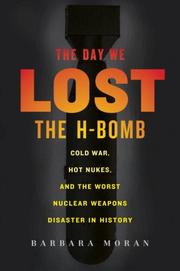Check nearby libraries
Buy this book

From the Publisher: In The Day We Lost the H-Bomb, science writer Barbara Moran marshals a wealth of new information and recently declassified material to give the definitive account of the Cold War's biggest nuclear weapons disaster. On January 17, 1966, a U.S. Air Force B-52 bomber exploded over the sleepy Spanish farming village of Palomares during a routine airborne refueling. The explosion killed seven airmen and scattered the bomber's payload-four unarmed thermonuclear bombs-across miles of coastline. Three of the rogue H-bombs were recovered quickly. Tracking down the fourth required the largest search-and-salvage operation in U.S. military history. Moran traces the roots of the Palomares incident, giving a brief yet in-depth history of the Strategic Air Command and its eccentric, larger-than-life commander, General Curtis LeMay, whose massive deterrence strategy kept armed U.S. bombers aloft at all times. Back on the ground, Moran recounts the myriad social and environmental effects of an accident that spread radioactive debris over hundreds of acres of Spanish farmland, alarmed America's strategic allies, and damaged Spanish-American diplomatic relations. As the American military floundered in its attempt to keep the story secret, the events in Spain sometimes took on farcical overtones. Constant global media hype was fueled by the hit James Bond movie Thunderball, with its plot about an atomic weapon lost at sea. In addition, there were the unwanted attentions of a rusty-hulled Soviet surveillance ship and even awkward public relations stunts, complete with American diplomats in swim trunks.
Check nearby libraries
Buy this book

Previews available in: English
Subjects
History, Nuclear accidents, Search and rescue operations, Hydrogen bomb, Military Airplanes, Accidents, Aircraft accidents, NonfictionPlaces
United States, Spain, Palomares Region, PalomaresTimes
20th centuryShowing 2 featured editions. View all 2 editions?
| Edition | Availability |
|---|---|
|
1
The Day We Lost the H-Bomb
2009, Random House Publishing Group
Electronic resource
in English
0345515234 9780345515230
|
zzzz
Libraries near you:
WorldCat
|
|
2
The day we lost the H-bomb: cold war, hot nukes, and the worst nuclear weapons disaster in history
2009, Ballantine Books
in English
0891419047 9780891419044
|
aaaa
Libraries near you:
WorldCat
|
Book Details
Edition Notes
Includes bibliographical references and index.
Classifications
The Physical Object
ID Numbers
Source records
Library of Congress MARC recordLibrary of Congress MARC record
Library of Congress MARC record
Internet Archive item record
Internet Archive item record
marc_openlibraries_sanfranciscopubliclibrary MARC record
Library of Congress MARC record
harvard_bibliographic_metadata record
Work Description
In The Day We Lost the H-Bomb, science writer Barbara Moran marshals a wealth of new information and recently declassified material to give the definitive account of the Cold War's biggest nuclear weapons disaster. On January 17, 1966, a U.S. Air Force B-52 bomber exploded over the sleepy Spanish farming village of Palomares during a routine airborne refueling. The explosion killed seven airmen and scattered the bomber's payload--four unarmed thermonuclear bombs--across miles of coastline. Three of the rogue H-bombs were recovered quickly. Tracking down the fourth required the largest search-and-salvage operation in U.S. military history.Moran traces the roots of the Palomares incident, giving a brief yet in-depth history of the Strategic Air Command and its eccentric, larger-than-life commander, General Curtis LeMay, whose massive deterrence strategy kept armed U.S. bombers aloft at all times. Back on the ground, Moran recounts the myriad social and environmental effects of an accident that spread radioactive debris over hundreds of acres of Spanish farmland, alarmed America's strategic allies, and damaged Spanish-American diplomatic relations.As the American military floundered in its attempt to keep the story secret, the events in Spain sometimes took on farcical overtones. Constant global media hype was fueled by the hit James Bond movie Thunderball, with its plot about an atomic weapon lost at sea. In addition, there were the unwanted attentions of a rusty- hulled Soviet surveillance ship and even awkward public relations stunts, complete with American diplomats in swim trunks. The Day We Lost the H-Bomb is a singular work of military history that effortlessly and dramatically captures Cold War hysteria, high-stakes negotiations, and the race to clean up a disaster of unprecedented scope. At once epic and intimate, this book recounts in stunning detail the fragile peace Americans had made with nuclear weapons--and how the specter of imminent doom forced the United States to consider not only what had happened over Palomares but what could have happened. This forgotten chapter of Cold War history will grip readers with the tension of that time and reawaken the fears and hopes of that dangerous era.From the Hardcover edition.
Community Reviews (0)
Feedback?History
- Created February 18, 2009
- 14 revisions
Wikipedia citation
×CloseCopy and paste this code into your Wikipedia page. Need help?
| November 30, 2023 | Edited by MARC Bot | import existing book |
| December 22, 2020 | Edited by MARC Bot | import existing book |
| July 16, 2019 | Edited by MARC Bot | import existing book |
| June 29, 2019 | Edited by MARC Bot | import existing book |
| February 18, 2009 | Created by ImportBot | Imported from Library of Congress MARC record |













